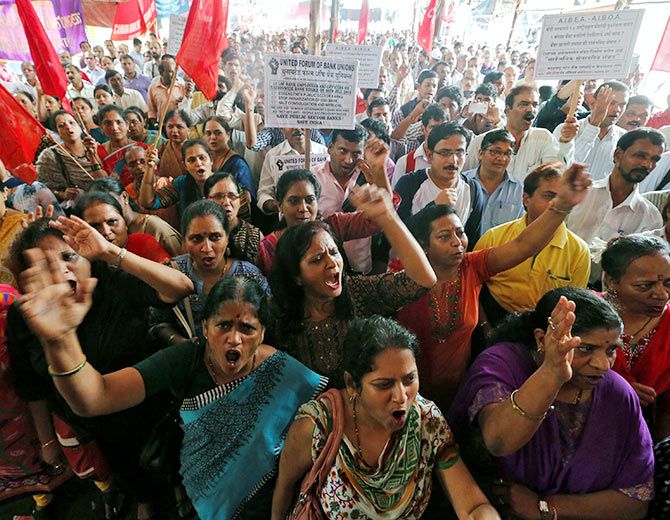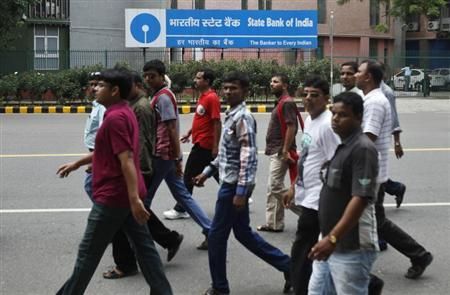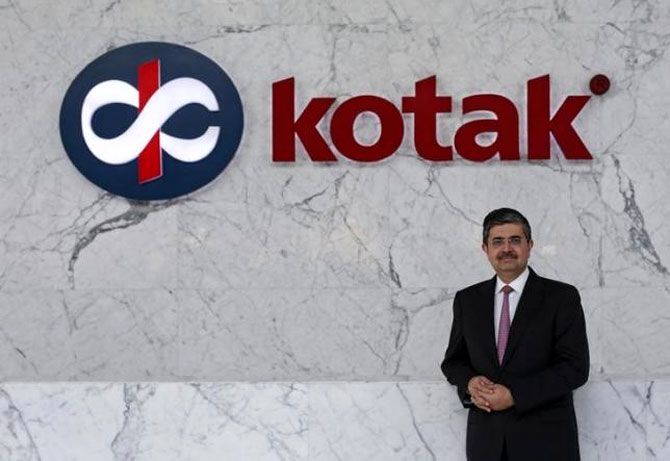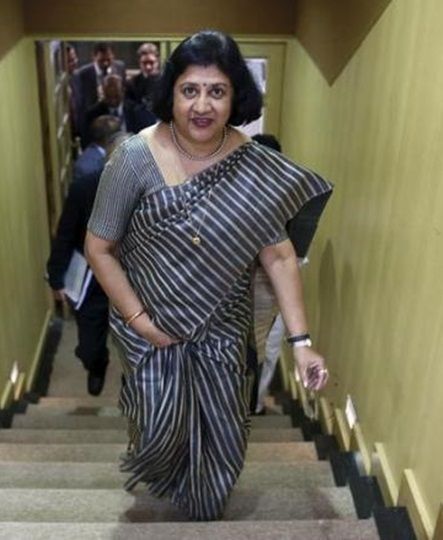'SBI is already too big. Too big to fail.'
'It already is a moral hazard. What will it do with 20,000 branches that it cannot do with 14,000, especially in these days of online and mobile banking?' asks banker S Muralidharan.

Recently PSU banks' staff went on strike, protesting the proposal to merge the State Bank of India with its subsidiaries. The proposal concerns only the SBI group for the moment.
Why then should the other PSU banks' staff be concerned? They see this as the trial balloon, the thin end of the wedge, and fear mergers involving other PSU banks in the future. The officers and workmen unions display a rare sense of unity in scuttling any such future plan.
Could merging banks to create bigger ones be such a bad idea?
The answer depends on whom you ask. Almost no one except the government believes that merging banks to create bigger ones is a good idea. It was mooted by the Manmohan Singh government and is being enthusiastically pushed forward by the Narendra Modi government. That fact alone should qualify this idea to be a very sound one or a very bad one and we shall soon see which.
The present government's economic justification and political motivation in pushing for mergers is murky at best. The rest of the political spectrum does not see an angle in it yet, so they are keeping their powder dry. For now.
The Left will viscerally oppose anything that weakens the unions, even the ones representing well-paid bank employees.
Motivations of other stakeholders for opposing it are simple and clear enough: The employees fear it could lead to shutting down branches and to staff retrenchments; the unions fear erosion of their power; the public fears bigger banks will be even less responsive to their needs and the officer cadre must surely be concerned about fewer opportunities for career progression.
What is the problem the proposed mergers are purporting to solve?
Is this merger mania a well thought out response to the banks' problems, tackling them at a deep level, or is it just a superficial whim?
Is it good for the public whom the banks purport to serve or is it for the benefit of the owners (the government) and the employees?
What or who is driving this merger mania, and why? We may never know the true answer to the last question. I shall therefore attempt to parse the other ones and leave it to the readers to draw their own conclusions.
It is accepted wisdom that business organisations must keep growing or risk decline and demise. This view holds that stasis is lethal.
Some question this drive for perpetual growth citing finiteness of the world and everything in it. We can reasonably assume that in India we are nowhere near these limits and that there is adequate room for growth still.
Organisations can grow organically or through acquisitions and mergers. To grow organically it takes time, lots of time.
Today's leading banks have grown over 100 years or so -- in some cases even 200 years. The recipe for success in banking appears to be slow cooking over a long time.
For those unable or unwilling to wait, mergers and acquisitions provide a short cut to growth. Such growth through merger comes at a cost, though.
There can be many superficial reasons cited for mergers and acquisitions, but generally they fall into one of three fundamental categories:
- a. Deepening and widening the customer base;
- b. Doing more at lower cost;
- and c. reacting to competition.
Staying ahead of competition in business is akin to the human instinct for survival. Losing ground to competition is the beginning of the end.
If your competitor is growing fast and looks set to swamp or outflank you in the market place, you try to do it to them before they do it to you.
Mergers or acquisitions provide a quick route to relative safety in such instances. When the French bank BNP acquired Paribas in 1999, it was to forestall its bitter rival Societe Generale from acquiring Paribas.
Some grow by expansion beyond their home turf where they feel they have reached the point of diminishing returns. Organic growth in new areas may be slow and time consuming.
A merger with a player strong in that area is a viable strategy, other things working out.
This is particularly relevant in India. There are banks which are strong in their home turf, such as one state, with insignificant presence outside of it.
Indian Bank and Indian Overseas Bank have extensive presence in Tamil Nadu, but are sparse outside it.
United Bank and United Commercial Bank have strong presence in the East. And so on.
SBI's presence is substantial across the country. The so-called 'regional' banks can focus on their own backyard and try to be the strongest there or spread across the country, losing focus and remaining weak everywhere.
Since nationalisation in 1969, they have favoured the latter approach.

In a continent-sized geography and economy such as India, there are opportunities for both types of banks: National ones as well as regional ones.
Being 'nation-wide' is not an easy game to play and requires a different mind set, sound knowledge of its different areas of operation, and a clear and sound business logic for being outside of its zone of comfort.
Going outside your home turf carries many risks, not the least of which is the lack of familiarity with local culture and conditions. This applies equally well inside the organisation as well as outside, in the market.
Ignoring the role of culture inside and out can have disastrous consequences.
The only bank to have achieved expansion outside home turf with any degree of success is Citibank. Bbut their recent retreat from various non-US markets such as Japan underscores the importance of this aspect.
Banks can also grow by acquiring different types of customers and acquiring skills and capabilities to service those customers.
Many banks forayed into investment banking, mainly through acquisitions, in order to capture the lucrative income streams that were associated with this activity. This was also due partly to the fear of generic competition from pure investment banks.
During the 1990s, when 'disintermediation' was on everyone's lips, banks feared that mutual funds, insurers and pension funds would compete for their retail depositors and investment banks for their corporate customers.
They therefore attempted to provide all these services, where regulations permitted; where they could not, banks set up separate entities to do so.

Sometime critical mass was achieved rapidly through acquisitions and mergers.
Not long after the private banks were licensed in 1990s, HDFC Bank absorbed Times Bank and Centurion Bank, and ICICI Bank merged with its parent ICICI Ltd and Bank of Madura.
More recently Kotak Mahindra Bank acquired Vysya Bank, the Indian arm of the ING group. Suddenly Kotak's valuation vaulted into the top league -- it is reported that its market cap now equals that of 23 State-owned banks combined.
Just as the size and income of the merging banks add up, and so do costs. The more they cut costs below the sum of the pre-merger costs, the more likely the merger will be a financial success.
The cost-cutting is usually achieved by eliminating duplications in branch network, back office, and administrative functions.
The problem is that these are the areas that employ the most people and downsizing manpower is fraught with difficulties.
Combining client bases can also bring to the fore issues like over-exposure to clients, business sectors, or geography. '
Merging to achieve economy will work only if the network overlap is significant and rapid downsizing of network and workforce are feasible.
One more caveat: Such mergers are unlikely to succeed if the merging banks already have significant number of common clients which will only increase the concentration risk.
Such issues are usually overlooked in the warm glow of initial (usually manufactured) positive response from the markets and media.
Mergers succeed when the key pre-requisites are met -- not just initially, but can be sustained over a period of time.
The course of mergers, like that of true love, never does run smooth.
While justifications for mergers appear logical and work precisely in business school class rooms (and some board rooms), in real life their locus is anything but.
In the Indian context downsizing is NOT a politically and socially viable option, especially for government-owned banks. Concentration risk can also be high.
Western market economies have rich experience of mergers, break-ups, and failures and thus can be expected to approach mergers and break-ups with a healthy dose of scepticism.
In the US alone 465 banks failed between 2008 and 2012. Most of them had assets running into tens of billions of dollars.
In the same period a handful of insignificant cooperative banks collapsed in India, not enough to impinge on the public consciousness.
In India where mergers and break-ups have been rare due to unfavourable regulatory environment, the public can easily be persuaded into believing that mergers are god's answer to our banking woes.
In this atmosphere a healthy and informed examination of the issue is replaced by unquestioning adoration or unprincipled opposition for the proposal.

What can be the compelling logic for the merger of SBI with its subsidiaries?
It cannot be for reasons of reducing the vexing NPAs (non-performing assets) for they do not cancel out when two banks merge; they add up instead.
Believing that a merger would solve the NPA problem is like believing that a marriage between two insolvents will create a wealthy couple.
The mergers will not confer any advantage on SBI that it presently lacks, in terms of geographical spread, client base, or width of product offerings.
On the other hand, managing the resulting colossal size may very well distract SBI's management from their business-focus.
SBI is already too big. Too big to fail. It already is a moral hazard. What will it do with 20,000 branches that it cannot do with 14,000, especially in these days of online and mobile banking?
Each of its subsidiaries was once a bank from a princely state and operates mainly in its historical backyard. They all have a distinct connect with the local populace: The phrase 'State bank of' is absent when locals refer to them; instead they are known locally as 'Mysore Bank', 'Travancore Bank', etc.
They have something valuable which is the clear-cut identity as belonging to the local soil. Replacing that with an impersonal 'global' brand is not a good idea.
What can SBI's subsidiaries gain from the merger apart from a bigger balance sheet and better capital base?
Will they be able to rationalise the branch overlap and trim their staff levels?
Do they bring significant number of unique (that is, not already SBI's) clients to the marriage, particularly lucrative corporate clients?
What kind of unique skills in selling products and services do they bring to the table?
The answer, alas, is in the negative to each of these questions.
On the other side, the subsidiaries will lose their unique brand identity with strong links to their specific 'home' communities and a merger will destroy that bond and affinity built over their long existence.
We have seen in the political arena that the so-called 'national parties' are losing ground to the local ones which the voters appear to identify closely with. To think that somehow banks are immune to this trend is refusing to see the writing on the wall.
Even as the merger talk fills the air, SBI is considering shedding 30 per cent of its branches. How exactly does one reconcile these?
There is a mistaken belief that size confers advantages in the market place. This is like believing that the largest athletes run the fastest, jump the highest and longest, and throws sundry objects the farthest.
Even in Sumo wrestling, the world of very big men, the biggest do not always win. The nimblest, cleverest and the quickest-thinking do.
In cricket, the best batsmen have not been big men -- Bradman, Gavaskar and Tendulkar come to mind.
Rod Laver, the best of the best in tennis, was known as 'Pocket Rocket' in reference to his size, or the lack of it.
Dinosaurs did not survive the catastrophic asteroid impact 66 million years ago; the survivors were mostly species weighing less than 25 kilos.
Size is no protection against failure or extinction. 88 per cent of the Top 500 American firms of 1955 had disappeared by 2014.
What is the antidote to our banking woes if it is not creation of larger banks through mergers? Simply put, there is none.
However creation of a well-diversified and dispersed banking system can ensure that a banking problem does not snowball into a full-blown economic crisis.
If the banks follow prudent business practices and take only such risks as they can easily afford, a mass banking failure may be averted during periods of economic uncertainties.
The trick is to realise that banks will fail no matter what and limit their size to something that can be allowed to fail.
A robust deposit insurance should take care of the most vulnerable clients when banks fail.
The simplest solutions are usually the best and the most practicable.
Why are we no longer talking of basic prudent banking?
Better training of staff?
Better risk management?
Why is every bank rushing to lend to the dubious ventures of the same playboys?
I was shocked to read in the press that a businessman who had defaulted on a loan of less than Rs 5 crore (Rs 50 million) in 1990 now owes the banking system about Rs 40,000 crore (Rs 400 billion), all of it bad!
Surely, an entire generation of bankers have failed the diligence test and betrayed the trust placed on them.
There are 12 small banks known as the 'old private banks' that have been operating successfully for decades. They have somehow managed to flourish despite their small sizes, competition, economic ups and downs, their own excessive focus and concentration on small communities, limited access to technology and minuscule networks.
If that is so, then it is certainly possible for banks with hundreds of branches and SBI as parent to survive and flourish on their own. Merger as a necessary pre-condition for their continued survival is thus a myth.
There is a lesson that our banking authorities can learn from the world of biology: It is said that around the year 1900 the US had under cultivation over different 100 varieties of corn. These have now been reduced to just 4 through selective and cross breeding in an effort to maximise yields and profit.
A blight can now wipe out the entire American corn crop whereas it was well nigh impossible a hundred years ago. The lack of diversity, the concentration in just a few genetic strains, has left the corn industry very vulnerable to diseases.
Is this what we want for our banking sector? Can we afford it?
When the day of reckoning arrives, and surely it will, the larger the bank, the bigger the fall, and louder the crash.
To put it bluntly, the government that proposes bigger banks is guilty of planting the seeds of a future catastrophic meltdown in the banking system with dire consequences to the economy.
Bigger banks mean they cannot be allowed to fail, but will have to be bailed out by the government in order to avert a contagion.
Why do bail-outs matter? They matter because government bailouts of banks for bad lending are a clear case of transferring public wealth to private playboys like Mallya.
It is unethical, unfair, unsustainable and immoral.
S Muralidharan retired as the managing director of BNP Paribas after serving the bank for 20 years. He began his banking career at the State Bank of India and worked at SBI for 12 years.











 © 2025
© 2025